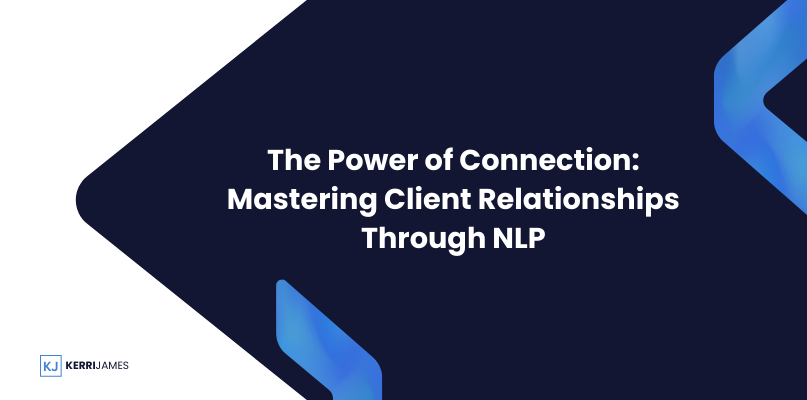In the dynamic and often challenging world of legal practice, technical expertise is undoubtedly essential, but it’s only one piece of the puzzle. The other, equally crucial piece, often the one that truly sets successful firms apart, is the ability to connect with clients on a deeply human level. Building strong, trusting relationships, founded on empathy, understanding, and genuine connection, is the cornerstone of a thriving and impactful legal practice. When clients feel truly heard, valued, and understood, they are more likely to open up, share vital information, and ultimately, place their confidence and trust in your firm’s ability to navigate their legal challenges. But how do you cultivate these vital connections effectively and efficiently, especially in the fast-paced, demanding environment of the legal profession? The answer lies in the transformative power of Neuro-Linguistic Programming (NLP). NLP offers a rich and diverse toolkit of techniques designed to enhance communication, build rapport rapidly, and create exceptionally positive client experiences from the initial consultation to the final resolution. Let’s explore in depth how your law firm can harness the remarkable potential of NLP to revolutionize client relationships and achieve unprecedented success.
Mirroring and Matching: The Subtle Art of Creating Instant Connection
Imagine a prospective client entering your office, feeling a mix of anxiety, uncertainty, and perhaps even trepidation. They are facing a legal challenge, a significant life event that has brought them to your door, and they need someone they can trust implicitly. By subtly mirroring their body language—their posture, their hand gestures, even the rhythm of their breath (with sensitivity and discretion)—you can create an unconscious sense of connection, putting them at ease and fostering a sense of trust. This isn’t about mimicking or imitating; it’s about establishing a subtle harmony, a sense of shared experience that transcends words. If they lean forward, you might subtly lean forward as well. If they speak softly, you might adjust your tone to match. These small, almost imperceptible reflections communicate empathy, understanding, and a willingness to connect on their level. I vividly recall a particularly challenging case where a client arrived visibly agitated and distressed. By subtly mirroring his posture and tone, I was able to de-escalate the tension and create a more relaxed atmosphere, allowing him to open up and engage more constructively. This simple act of mirroring created a bridge of understanding, allowing him to feel heard, seen, and validated.
Pacing and Leading: Guiding the Conversation with Skill and Empathy
Once you’ve established a foundation of rapport through mirroring, you can begin to subtly guide the conversation, steering it towards productive outcomes while maintaining the client’s sense of comfort and control. This is where the art of pacing and leading comes in. Start by matching their pace of speech and energy level, demonstrating that you are attuned to their current emotional state. Then, gradually and subtly shift your own pace and observe whether they unconsciously follow your lead. This refined technique allows you to gently steer the interaction, creating a more focused, productive, and comfortable environment for open communication. It’s particularly effective in managing the flow of information, ensuring the client feels heard and respected, and subtly guiding the conversation towards constructive solutions. I remember a case where a client was initially hesitant and unwilling to discuss certain sensitive aspects of their situation. By pacing their initial reticence and then gradually shifting to a more open and encouraging tone, I was able to create a safe and supportive space for them to share the necessary details, ultimately enabling us to develop a more effective legal strategy.
The Unspoken Language of Connection: Harnessing the Power of Body Language
Our bodies are constantly communicating, often conveying messages more powerful than words. In the legal profession, where trust and credibility are paramount, being acutely aware of your body language is not just important; it’s essential. Maintain an open posture—uncrossed arms and legs—to project approachability, receptiveness, and a genuine willingness to listen. Make and maintain appropriate eye contact (while being mindful of cultural differences) to demonstrate respect, attentiveness, and engagement. A genuine, warm smile can be remarkably disarming, putting clients at ease and fostering a sense of connection. As my esteemed mentor, Chris Mullins, wisely observed, “A smile is the universal language of kindness, a bridge that connects hearts and minds.” It can convey warmth, empathy, and reassurance, building trust and rapport in ways that words alone cannot.
Active Listening: The Heart and Soul of Effective Communication
True listening transcends simply hearing the words spoken; it involves deeply understanding the emotions, the unspoken messages, the nuances, and the underlying needs being communicated. Active listening requires focused attention, not just to the words themselves, but to the client’s tone of voice, their inflection, their facial expressions, their body language, and the subtle cues that often reveal more than words ever could. Ask clarifying questions, not merely to gather information, but to demonstrate genuine interest and a commitment to understanding their perspective fully. Summarize their points periodically, both to ensure accurate comprehension and to reassure them that their voice has been heard and their concerns acknowledged. Offer verbal affirmations like “I understand” or “I hear you,” validating their feelings and strengthening the bond of trust. I recall a complex case where active listening proved to be the key to unlocking a critical piece of information. The client was describing a convoluted situation, and by listening intently, not just to his words but to the subtle hesitations and shifts in his tone, I detected a crucial detail that had previously been overlooked. This seemingly small observation significantly impacted the course of the case, demonstrating the profound power of truly active listening.
Sensory Acuity: Speaking the Client’s Language for Deeper Connection
NLP emphasizes the importance of sensory acuity – the ability to recognize and respond to a client’s preferred sensory language, the way they perceive and process information. Do they tend to favor visual language (“I see what you mean”), auditory language (“I hear you”), or kinesthetic language (“I feel that’s the right approach”)? By identifying their dominant sensory system, you can tailor your communication to resonate more deeply and effectively, creating a stronger connection and enhancing understanding. For instance, if a client primarily uses visual language, incorporating visual aids, diagrams, or metaphors can significantly improve their comprehension of complex legal concepts, making the information more accessible and memorable. This personalized approach strengthens communication, fosters rapport, and demonstrates that you value their unique way of processing information. In my experience, adapting my communication style to match a client’s sensory preferences has consistently led to improved comprehension, greater engagement, and increased satisfaction.
Building Rapport Across the Communication Spectrum: Adapting to the Digital Age
The principles of NLP are not limited to face-to-face interactions; they are equally applicable across the spectrum of communication channels, including phone calls, video conferences, and email correspondence. In today’s digitally driven world, mastering the art of communication across diverse platforms is essential for building strong client relationships. On the phone, pay close attention to vocal tonality, pacing, and word choice, using your voice to convey empathy and build rapport. In emails, strive for personalization, demonstrating genuine interest in the client’s situation and avoiding generic, impersonal templates. Even in video conferences, mirroring and matching techniques can be subtly employed to create a sense of connection and foster a more engaging and productive interaction.
Advanced NLP Techniques: Delving Deeper for Greater Impact
Once your team has a firm grasp of the foundational NLP techniques, consider exploring more advanced methods to further deepen client connections and achieve even more impactful results:
- Anchoring: This powerful technique involves associating a positive feeling or state with a specific touch, word, or gesture. By subtly triggering this “anchor” during challenging moments, such as difficult conversations or stressful negotiations, you can help clients access a more resourceful and empowered state, enabling them to navigate these challenges more effectively and confidently.
- Reframing: Reframing is a valuable tool for shifting the client’s perspective on a situation by presenting it in a different, more empowering, or solution-oriented light. This can be particularly helpful in diffusing negative emotions, overcoming limiting beliefs, and fostering a more positive and proactive mindset.
- Meta-Model: The Meta-Model comprises a set of linguistic tools designed to uncover the deeper meaning and underlying assumptions behind a client’s words. By asking specific, targeted questions, you can gain a more profound understanding of their thoughts, beliefs, motivations, unspoken concerns, and the true meaning behind their words.
NLP in Action: Real-World Applications in the Legal Profession
Imagine this scenario: a potential client contacts your firm, feeling overwhelmed, confused, and uncertain about how to navigate their legal challenges. The receptionist, trained in NLP techniques, uses a calming tone and subtle mirroring to immediately establish rapport, creating a sense of trust and reassurance from the very first point of contact. During the initial consultation, the attorney employs pacing and leading to guide the conversation gently, creating a comfortable atmosphere where the client feels heard, understood, and respected. Throughout the legal process, active listening and sensory acuity enable the legal team to anticipate and address the client’s needs and concerns proactively, resulting in more personalized, effective, and client-centered representation.
The Transformative Benefits of NLP: Elevating Your Practice and Client Relationships
Integrating NLP techniques can bring about a profound and positive transformation in your law firm, impacting not only client relationships but also overall firm performance and success:
- Enhanced Client Satisfaction: Clients who feel genuinely understood, valued, and respected are demonstrably more likely to express satisfaction with the services they receive, leading to positive testimonials, referrals, and a stronger firm reputation.
- Improved Communication: NLP fosters clear, concise, and effective communication, minimizing misunderstandings, enhancing client-attorney collaboration, and streamlining the entire legal process.
- Strengthened Client Relationships: Building rapport through NLP cultivates lasting, mutually beneficial relationships built on a foundation of trust, respect, and open communication.
- Heightened Negotiation Skills: Applying NLP principles to negotiations can empower your attorneys to achieve more favorable outcomes for clients, securing better settlements, resolutions, and overall results.
- Reduced Stress and Anxiety: By fostering a more relaxed, supportive, and empathetic environment, NLP can help reduce stress and anxiety for both clients and your legal team, creating a more positive, productive, and harmonious work environment.
Integrating NLP into Your Firm’s DNA: A Cultural Shift Towards Client-Centricity
Integrating NLP into your firm’s culture requires a commitment to training, practice, ongoing refinement, and a fundamental shift towards a client-centric approach. Encourage your team to participate in NLP workshops, explore valuable resources like “Introducing NLP” by Joseph O’Connor and John Seymour or “NLP for Dummies” by Romilla Ready and Kate Burton, and dedicate time to practicing these techniques in their daily interactions with clients and colleagues. Create a supportive and collaborative environment where team members can openly share their experiences, learn from each other’s successes and challenges, and continually refine their NLP skills. You can find additional information on our website [insert internal link here] about incorporating data-driven strategies and client-centric approaches into your law firm’s operations.
Measuring the Impact: Demonstrating the Value and ROI of NLP Integration
To effectively assess the impact of NLP implementation on your firm’s performance, track key metrics such as client satisfaction scores, client retention rates, the number of positive testimonials and referrals received, and the overall success rate of cases. Regularly solicit feedback from your team to identify areas for improvement, celebrate successes, and continually refine your approach to NLP integration. By measuring the tangible impact of NLP, you can demonstrate its value and return on investment, justifying continued investment in training, development, and implementation.
Creating Trust and Connection from the First Interaction: The Foundation of Lasting Client Relationships
The first interaction with a potential client is a pivotal moment. It sets the tone for the entire relationship and can significantly influence their decision to entrust you with their legal matters. In the legal field, where trust is paramount, creating a strong initial connection is not just desirable; it’s essential for success. This crucial first impression shapes the client’s perception of your firm’s competence, empathy, and commitment to their well-being. By leveraging NLP techniques, you can transform this initial encounter into a powerful opportunity to build rapport, establish trust, and lay the foundation for a lasting and mutually beneficial relationship.
The Power of the First Impression: Setting the Stage for Success
The human brain is wired to make rapid judgments based on initial observations. Within seconds, a potential client forms an impression of your firm, influenced by everything from the receptionist’s greeting to the attorney’s demeanor and the overall atmosphere of the office. This first impression, often subconscious, can significantly impact their decision-making process. A positive first impression creates a sense of ease, trust, and confidence, while a negative one can raise doubts and create barriers to communication. By understanding the psychology of first impressions and utilizing NLP techniques, you can consciously shape this initial encounter to create a positive and impactful experience for potential clients.
NLP Techniques for Instant Rapport: Bridging the Gap from Stranger to Trusted Advisor
NLP offers a range of powerful techniques to quickly establish rapport and build trust from the first interaction:
- Mirroring and Matching Revisited: Subtle Reflections of Understanding: As discussed earlier, mirroring and matching involve subtly reflecting the client’s body language, tone of voice, and even their breathing rhythm. This creates an unconscious sense of connection, communicating empathy and understanding without uttering a single word. In the initial interaction, mirroring can be particularly effective in putting the client at ease, especially if they are feeling anxious or uncertain.
- Verbal Pacing and Leading: Creating a Harmonious Flow of Conversation: Verbal pacing and leading involves matching the client’s pace and rhythm of speech and then subtly guiding the conversation towards productive areas. This technique can be used to create a sense of rapport and subtly steer the conversation towards important topics, such as the client’s needs and concerns.
- Sensory Acuity in Action: Speaking Their Language from the Start: Pay close attention to the client’s language patterns and identify their preferred sensory system (visual, auditory, or kinesthetic). By adapting your language to match their sensory preferences, you can create a more impactful and resonant connection from the outset. For example, if a client uses visual language (“I see what you mean”), incorporating visual aids or metaphors can enhance their understanding and engagement.
- Active Listening from the First Word: Demonstrating Genuine Interest: Active listening is crucial throughout the client relationship, but it’s especially important in the initial interaction. By actively listening to the client’s concerns, asking clarifying questions, and summarizing their points, you demonstrate genuine interest and empathy, building trust and laying the groundwork for open communication.
- Empathetic Statements: Validating Emotions and Building Connection: Using empathetic statements, such as “I understand how frustrating this must be” or “I can see why you’re concerned,” can validate the client’s emotions and create a sense of shared understanding. This simple act of acknowledging their feelings can go a long way in building rapport and establishing trust.
Creating a Welcoming Environment: Setting the Stage for Positive Interactions
The physical environment of your office also plays a significant role in shaping the client’s first impression. A clean, organized, and welcoming reception area can create a sense of professionalism and ease. Consider incorporating elements that evoke a sense of calm and reassurance, such as comfortable seating, soft lighting, and calming artwork. The receptionist’s greeting is equally important. A warm, welcoming smile and a genuine expression of interest can set a positive tone for the entire interaction.
Beyond the First Impression: Maintaining Momentum and Building Lasting Relationships
While the first interaction is crucial, it’s only the beginning. Maintaining the momentum and continuing to build rapport throughout the client relationship is essential for long-term success. Consistency is key. Ensure that every interaction with the client, whether in person, over the phone, or via email, reflects the same level of empathy, respect, and attentiveness that was established in the initial meeting.
The Ripple Effect of Positive First Impressions: Building a Strong Referral Network
Positive first impressions not only benefit individual client relationships but can also have a ripple effect, leading to valuable referrals and a stronger firm reputation. Clients who feel valued and understood are more likely to recommend your services to others, creating a powerful network of referrals that can significantly contribute to your firm’s growth and success.
Key Takeaways: Mastering the Art of First Impressions
- Preparation is Key: Before meeting a new client, take a moment to review their file and anticipate their needs and concerns. This preparation demonstrates respect and allows you to tailor your communication accordingly.
- Be Present and Focused: Put aside distractions and give the client your undivided attention. This demonstrates respect and allows you to fully engage in active listening.
- Be Authentic and Genuine: Clients can sense insincerity. Be yourself and let your genuine empathy and concern shine through.
- Follow Up: After the initial meeting, follow up with a brief email or phone call to reiterate your commitment to their case and answer any outstanding questions. This reinforces the positive impression and strengthens the connection.
By mastering the art of creating positive first impressions and consistently applying NLP techniques throughout the client relationship, you can build a strong foundation of trust, cultivate lasting relationships, and achieve exceptional results for your clients and your firm. This focus on connection, empathy, and understanding sets the stage for a successful and rewarding legal partnership, benefiting both the client and the firm.
Final Thoughts
In the increasingly competitive landscape of legal practice, building strong, enduring client relationships is no longer a desirable asset; it’s a strategic imperative. NLP provides a powerful and versatile toolkit for mastering the art of connection, enhancing communication, and creating a truly positive and impactful client experience. By embracing NLP and weaving its principles into the very fabric of your firm’s culture, you can gain a significant competitive advantage, fostering trust, deepening understanding, and ultimately, achieving optimal outcomes for your clients and building a legacy of lasting success for your practice.










